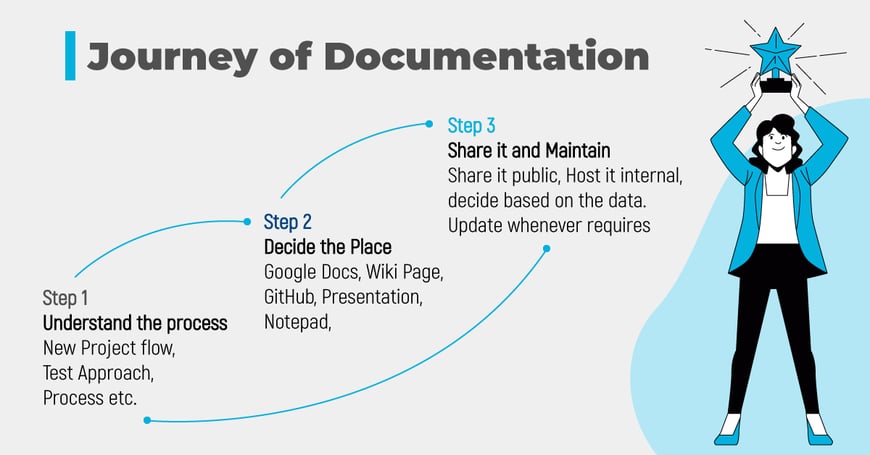Quality Assurance (QA) is an essential part of any Software Development process. Software testers perform various tasks to test the entire application or the software components.
For some process we as Testers go way beyond and do our R&D. In certain scenarios, Testers will be the sole carriers of some knowledge. What type of knowledge or information is to be documented? How does one ensure that the knowledge is not lost when team members leave the project? How does one track progress and measure the effectiveness of the testing efforts? How does one ensure that testing is done consistently across the project?
For all the above questions, the only answer is Documentation. Documentation is the only way to ensure that the processes are followed. Documentation also helps in the communication of the current status of the project to the stakeholders. It also helps the QA team to maintain consistency in the testing process. It helps to have a record of the performed testing activities.
However, documenting work is often overlooked or not given enough importance. This can lead to misunderstandings, delays, decreased productivity, and loss of knowledge. In this blog post, we will learn the importance of documentation, what can be documented, and explore the best practices for documenting QA work to improve collaboration, clarity, and efficiency.
What Can Be Documented and Why?
A lot of artifacts and processes are involved during the Software Testing Life Cycle. As part of the traditional way, we write Test Strategies, Test Plans, Test Scenarios, Test Cases, Test Results, Traceability Matrix, Status Reports, and Test Reports. During the testing life cycle, besides the artifacts mentioned above, Testers are involved and deep dive into some areas that are good to be documented and stored somewhere for future reference.
Based on my experience, let’s explore the list that can be documented other than the artifacts mentioned above:
- Test requirements and specifications
- Step-by-step tutorials for test cases and user flows
- Test Data Creation process and details
- Test Environment Details and Setup
- Tools and Technologies used along with the Installation procedure
- Stakeholder details or Point of contact information
- Detailed Test Approach and Project flow with upstream and downstream dependencies
- Failures or Mistakes (What could have been done differently) and Lessons learned from every project
- Important approvals and e-mail communications
- Links to the important documents
- Generic login information for external systems
- Timelines and milestones
- Information about the team and their availabilities (Holiday Tracker)
Okay, we use a lot of information during our testing process. Why should we document and store them?
Documenting serves multiple purposes, let’s see in detail below:
-
Increased accuracy: Documentation helps us validate accurate information about a system. This allows them to assess the correctness of a certain feature and improve its performance.
-
Easier debugging: For complex flow or process, documentation can serve as an aid for testers to debug errors that may have gone unnoticed earlier.
-
Enhances Collaboration: Effective documentation facilitates communication among all of the stakeholders engaged in the software development process. It facilitates the understanding of testing requirements, test strategies, and test cases by testers, developers, and project managers. Collaboration becomes simpler when all team members are on the same page, resulting in more efficient and successful testing.
- Improved Communication: When we have everything documented, it’s easy to explain the complex topics to the stakeholders and it makes the communication simpler. Clear documentation helps QA teams effectively communicate their findings to developers, stakeholders, and other team members.
- Ensures consistency: Having a detailed set of guidelines surrounding testing activities can help maintain uniformity across the team. Everyone should be on the same page when it comes to the testing process. Documentation provides an easy-to-follow reference to ensure each tester can validate the same areas.
- Knowledge Base: Documentation ensures that knowledge is not lost when team members leave the project. It helps new team members quickly understand the testing process and findings.
- Tracking Progress: Documenting QA work enables the tracking of test coverage, issues discovered, and their resolution. This helps in measuring progress and identifying areas for improvement.
- Legal and Audit Purposes: Documentation is essential for satisfying legal and regulatory responsibilities. It serves as proof of testing efforts and aids in ensuring regulatory standards are satisfied. Healthcare and banking, for example, have stringent regulatory standards that must be fulfilled. Documentation helps keep track of the testing activities and ensures that these standards are met.
- Enhanced reliability of software: With good documentation, testers can more easily detect defects that were previously ignored. This increases the software's dependability and assures greater performance across all platforms.
Steps in the Documentation Process
For multiple purposes we document. Generally, the documentation starts with the analysis.

Step 1: Understand the process
To document anything, you should first understand what you are documenting. Gain a solid understanding of what you are writing about. Gather all the information that you need to write about.
Step 2: Decide the Place (How and Where)
Inside a project when you are looking to document the test process, you should consider the mode and the location where you will store the documents. Whether you prefer to write as a Google Doc, Wiki Page, or Microsoft Word Document, depends on the type of information and the ease of access to the information for future reference.
Step 3: Share it and Maintain
Once you have curated all the necessary details, you can share them with the intended audience. Also, ensure to update the documents whenever necessary. It’s not a one-time activity. It should be a continuous process.
Best Practices for Documenting QA Work
“We are what we repeatedly do. Excellence, then, is not an act, but a habit.” - Aristotle, Greek philosopher.
To make QA documentation effective and efficient, follow these best practices:
1. Use Clear and Concise Language
While documenting, employ language that is clear, succinct, and easy to comprehend. Avoid using jargon or technical phrases that may confuse readers. To successfully communicate information, use brief words and bullet points.
2. Include Essential Information
Include the necessary information in the documents you create. This comprises information such as the test's objective, procedures to recreate a problem, expected and actual findings, and any supporting resources such as screenshots or log files. By providing detailed and precise information, you ensure that others can reproduce and comprehend the testing procedure. Make sure to add or link all the associated documents and external links.
3. Organize Documentation
Organize your documentation into logical segments to make it easy to read and explore. Divide the document into sections for distinct test cases or areas of emphasis. To highlight essential ideas or critical discoveries, use formatting choices such as headings, subheadings, bold, or italics.
4. Use Visuals
Visuals may improve the clarity and impact of your material significantly. Include images, diagrams, flowcharts, and mindmaps to show complicated ideas or problems encountered during testing. Visuals may significantly help readers comprehend the context and increase the overall efficacy of your content. Screen capturing and video recording can be helpful for documenting complex stuff.
5. Create Templates
To ensure everyone is documenting all important information, create templates that everyone can use to provide consistency.
6. Review and Revise
Always get the documents reviewed by the SMEs and other stakeholders to make sure they are accurate and up to date.
7. Update and Maintain Documentation
Quality assurance documentation is not a one-time task. It should be updated on a regular basis to reflect project changes and developing requirements. Maintain a well-organized system for documentation, version control, and access. This guarantees that everyone gets access to the most recent and up-to-date information.
Conclusion
Documenting is crucial for effective collaboration, knowledge sharing, and project success. Where there is a lack of documentation, there’s some chaos that needs to be handled. Effective documentation is essential for successful software testing practices. It facilitates communication, knowledge transfer, traceability, and regulatory compliance. By following best practices and giving importance to documentation, organizations can improve the quality of their software and enhance the overall testing process.
Remember, documentation is not just a box-checking exercise. It is a valuable tool that enables collaboration, accountability, and knowledge sharing among team members. So, don't overlook the importance of documentation in your software testing practice. Take the time to document your QA work effectively and reap the benefits in the long run.




%20(1).png?width=150&height=69&name=MuukTest-logo---light-background%20(3)%20(1).png)
.jpg?width=400&height=896&name=04_infographic_02%20(1).jpg)
.jpg?width=400&height=481&name=04_infographic_01%20(2).jpg)

